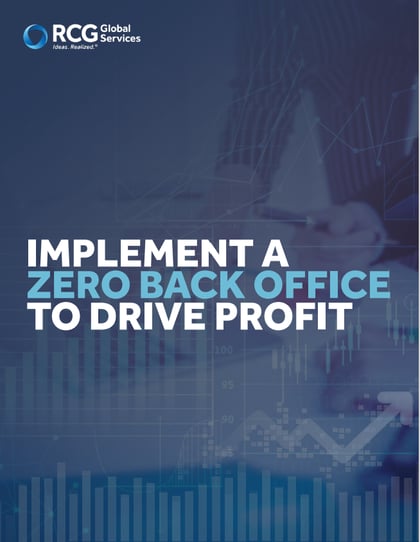Implement a Zero Back Office to Drive Profit
The key to unlocking the hidden profit is a zero back office with a strong foundation in the digital era of nimble Artificial Intelligence, automation, data, and analytics technologies
Increase Profit with a Zero Back Office

To achieve this goal, companies look to acquire other companies to gain economies of scale, while others invest heavily in marketing to increase the customer base. These are all great initiatives, but too often, the internal operations are overlooked as an opportunity to impact the bottom line. It is projected that 20 – 40% of a company’s revenue is lost due to process inefficiencies. Resolving these inefficiencies can re-direct profit back to the bottom line.
The key to unlocking the hidden profit is a zero back office with a strong foundation in the digital era of nimble Artificial Intelligence, automation, data, and analytics technologies. To leapfrog the competition, you need to understand the leakage of revenue hidden in the current processes and systems. The identification process is often challenging due to disjointed reporting, the culture of “this is the way we have always done it,” and false positives. Combining the digital era emerging technologies with a visionary implementation roadmap will achieve change in weeks instead of years as traditionally expected from historical programs.
Traits of a zero back-office organization

Efficient organizations are relentlessly identifying faster and systematic based processes, investing heavily in technology such as automation and AI, and pushing the technology boundaries.
Minimal manual efforts – Processes are highly automated using tools like RPA, AI, and system enhancements. Staff members can focus on strategic efforts and perform exception processing when an automation cannot complete a task. There are reviews to evaluate how technology can address the manual exceptions.
Simplistic Application Landscape – The number of systems is limited to the bare minimum, with each system providing the maximum value. Each system is fully integrated into the application ecosystem, and data stored in a consistent format in a centralized location.
Current Applications – Legacy applications are enhanced with the latest technology, and new systems are introduced, improving legacy application capabilities and providing new functionality. Every time a new application is introduced, historical applications are reviewed for removal as appropriate.
Smaller IT organization – The IT organization focuses on supporting the business users who are citizen developers. IT will have a small staff for monitoring production, supporting environments, and other tasks to ensure IT meets the business needs. The reduced team focuses on the more technical development challenges that support all business functions and those that are overly complex or require specialized technical skills.
Self-service options – For internal and external clients, most of the requests can be handled through automated means. With the appropriate access rights, they may inquire about delivery or perform an internal task with a chatbot managing the work. The support staff focuses on the more complex items such as managing a dispute or setting up a new environment but still has an automation presence to assist in the efforts.
Focused product offerings – The business refines the number and variation of products to only the highest profitable and projected future need. Product development is done through a modular framework approach that enables high reuse levels, resulting in more precise system requirements and reduced system complexity.
Customer-centric operating model – All activities, efforts, and investments are laser focused on delighting the customer. Every interaction is reviewed to ensure the least number of handoffs and enable them to interact on their terms through an Omnichannel experience.
Nimble response – The organization can respond to new market trends, new product demands, and innovative solutions without a multi-year program. The organization can implement changes with focused enhancements or technology updates in weeks, not years.
Analysis of trends – The organization restlessly focuses on production data, continually looking for trends, drops in productivity, or other indicators of a possible challenge or opportunity for the future. Simplified data access allows all resources from the CSR to the CEO access to the correct data for the right level. Any resource can find a new opportunity, and the company can take swift action to implement the idea.
Engaged Staff – The culture is one of cooperation and focuses on solving strategic issues. The staff will have time to evaluate current efforts and affect change either through updates or a citizen developer enhancement. The team will not be enveloped in basics tasks but rather business-changing efforts.
Deliver efficiency through enabling technology

The resulting IT landscape becomes one of clumsy technology combined with the inability to support the business needs and requires significant investment to make any minor update.
The challenge is to find the balance of risky new technology that can be efficient at a lower cost with predictable legacy technology that has limited capabilities at a higher cost. Over the past decade, many new efficient technology options have been introduced and proven in the market.
Consider these technologies that are ready to drive efficiencies in your application landscape:
Automation
This technology grouping comes in many different options ranging from Robotic Process Automation (RPA) to Optical Character Recognition (OCR) to business rules engines. The vendors in this space have been providing software both on-premise and in the cloud for over a decade. This technology focuses on removing the mundane and simplistic tasks from the human and performing it systematically.
If the action has predefined decision points and a human interface, the efforts can be automated.
The latest technology evolutions move into more gray/fuzzy areas where the technology can be trained through machine learning concepts. For example, it is now possible to have automation read an inbox email, scan the email for keywords or phrases, look up the account, and fill out an internal tracking ticket for the email. All of this is accomplished with no human intervention and can increase the accuracy over time through exception training.
Artificial Intelligence (AI)
This technology grouping is a framework built upon a variety of technology solutions. AI is a branch of computer science building machines that can perform more unstructured tasks that generally require human intelligence. Like automation, the technology companies have been around for many years and continue to evolve as more powerful computers and networking capabilities are delivered to the market.
One of the most known AI systems is from IBM, which had a few different systems from Deep Blue to Watson. AI uses multiple capabilities ranging from deep learning, natural language processing (NLP) to machine learning to identify trends, make business decisions and build strategies. For example, when purchasing something from Amazon, AI combines multiple inputs from shopping preferences from a similar customer profile, prior purchasing history, availability of the product, and market trends to make accurate recommendations.
AI uses various tools such as machine learning models, that are self-correcting over time, and deep learning, that reviews the decision’s outcome and improves subsequent recommendations. Amazon has been able to productize this solution and offer it as a service to any market through an API solution.
Chatbots
The concept of chatting has been available as early as the 1970’s using Unix talk and more publicly used in the 1980s with CompuServe Simulator. It was not until 2010’s chat functionality supporting the consumer to business capabilities was introduced through a chatbot. Today the capabilities range from a simplistic response to initial customer questions and route the customer to the appropriate agent to the very complex 100% automated responses.
This technology relies heavily upon Natural Language Processing (NLP) and machine learning to provide natural human-like responses instead of appearing to be a machine. As the chatbot usage increases, a database of questions and responses is built to allow the chatbot to answer additional questions and provide ever increasingly detailed replies.
For example, this technology can be leveraged to provide first-level consumer troubleshooting support instead of engaging with a CSR. This frees up agents to focus on other more complicated customer challenges and enables the customer immediate access to answers. This same technology can be expanded to internal operations such as help desk, HR, etc. For example, a team member could chat to reset a password or set up access to a system through a secured chat tool integrated with the back-end systems and helpdesk software.
Advanced Analytics
Data has become the new currency with an ever-increasing focus on quality, access, and enrichment. Companies today create, access, and store data in multiple data warehouses, systems, and output of reports. Modern data engineering practices have now evolved to take unstructured data from disparate systems and rationalize it into meaningful insights. Third parties can now enrich data and identity resolution techniques applied to identify the party or user uniquely.
Reporting tools have evolved from highly technical implementations to business friendly tools that can now process terabytes of data in short periods of time. Using the foundation of reliable data, the analytic tools can augment the staff member to identify trends and correlations not humanly possible due to a large amount of data.
Organizations can now understand their customer better, increase the accuracy of sales probability, and identify weak areas in the experience that cause friction. This unique view provides insight into new ways to operate the organization and areas for improvement.
Legacy System Modernization
Too often, we see our customers are enamored with the latest technology, newest capabilities, and integrations and overlook the current system’s capabilities. While it is not a simple plug and play solution, existing systems may have the capability to meet the business need with a minor adjustment, custom coding, or integration with an RPA or AI solution.
For example, accounts receivable reconciliation can be challenging due to the multiple requirements to match data from many different systems. Assuming the accounting system provides the needed capabilities, a solution can be developed that combines automated OCR capabilities to read the invoice with RPA to extract the accounting system’s comparison data and a lightweight AI to validate the comparison exceptions. This can extend the life of current systems while providing higher accuracy comparison in a reasonable manner.
Another example would be to migrate the mainframe capacities to a cloud native platform. While the mainframe has been a stable IT system for decades, the ability to scale, meet real-time needs, and cost maintenance require alternative solutions. Using a solution like Kubernetes, containerized cloud-based functionality enables on-demand scale at a lower cost with the option of APIs to extend the functionality. This provides a hybrid solution of reusing existing capabilities but in new technology at an efficient price point.
Find the clues to the inefficient puzzle

The impact of inefficiencies will be spread across the team’s efforts totaling a significant toll on productivity. Some of the symptoms of the challenge include:
Frequently Missed Deadlines – The communication between teams is challenging and often requires multiple meetings/emails to explain expectations and delivery needs. When looking at reasons for delays, do they include missed steps in a process such as setting up the development environment, lead times that were unexpectedly long, or details overlooked when submitting a request?
Resource Turnover is increasing – In some positions such as customer service and call center representatives, the turnover is expected to be high due to the nature of the position. When looking at other positions where the turnover is expected to be low, is the turnover rate increasing over time? This can indicate resources becoming burnt out, frustrated with the inability to make progress, or high expectations with low capabilities to deliver.
Retaining new hires is challenging – After selecting a new hire candidate, does the candidate remain with the company for a long duration, or are they quick to resign? When training the new candidate, do they take a long time to get up to speed due to the position’s complexity? In general, employees want to focus on their abilities to influence the company. If there are too many non-value added activities, employees will leave for new opportunities with other companies.
Rising costs have become expected – The amount of effort invested to complete a task continues to grow. Review the duration and effort to complete tasks over time. Is additional overtime or staff now required to complete the same task from before?
Decreases in Customer Satisfaction – Measurements like net promoter score, customer approval ratings, and other measures continue to decline. When staff members cannot deliver for the customer, take multiple steps to complete a task, or are required to complete administrative tasks, the ability to expend effort to delight the customer is significantly reduced. This can also manifest as inferior quality products and a large number of defects in production.
Changes in the Sales Win ratio – The sales loss ratio continues to increase, indicating that the teams cannot focus on creating the sales message. Is the team rushing to complete proposals, respond to RFI/RFPs, etc.? This can indicate the team is overloaded with other activities and non-value added efforts reduce focus time.
Lack of Reporting Clarity – Providing dashboards and reports is problematic because data silos within the organization or the source data are natively unavailable. This is an indication of unnecessary manual efforts. When systems are not fully integrated and data is not freely flowing, there is a loss of productivity because data or processes need to be managed manually.
Implement the change

It sounds straightforward – make a few minor tweaks, and the issues will go away on the surface. Once the problem is identified, the complexity of solving the problem becomes known as the solution can span across departments, technology, and organizational changes.
Define the challenge
The first step to solving any problem is the identification of the issue. We use a range of collection methods to best triangulate the challenge from multiple points of view.
Staff Interviews – Talk with the staff to determine their view of the problems, the challenges they face, and areas they believe should be improved. In our engagements, we have found the best source of ideas comes from the people performing the work. The responses will range from simple to complex to the impossible. It is the collection team’s job to sort through the answers and identify realistic versus unattainable solutions.
Process Documentation – Follow tasks from initiation to completion and document every step, handoff, and activity performed by both staff members and systematic updates. It is essential to keep the scope crisp and objectively document the steps consistently during the documentation phase. Too often, the scope increases, or there is bias introduced influencing the results. The goal is to understand objectively how the process works today.
Industry Benchmark – Review output metrics against industry standards to identify deficiencies that can be improved. Do not only look to just one industry but in other industries that provide similar types of experiences. In the digital world, the consumer is now judging their interactions with your company against the standards like Netflix, Starbucks, Amazon, Google, etc.
Application Rationalization – Review the current portfolio assessment of each application and system against the critical business and IT drivers. This will require evaluating each application to determine the business value received, the level of redundancy and manual effort required, the cost of maintenance, and the ability to support the business vision. Then force rank each of the applications to identify applications for modernization or retirement.
Customer Journey – Execute an outside-in review of the customer experience from the key customer personas. The first step will be to identify the key customer persona that interacts with the company daily. The next step is to document the experience from the customer’s perspective as they would interact. The documentation should include areas of excellence and items for improvement, taking into account the demands of a digital experience.
Impact the organization

The key difference will be the effort can be done in very small pieces and may not require a significant release to realize the value. Things like process changes can be done overnight and results can be reviewed within days – unlike major system investments which often take years. An organization alignment will take longer, but the results are also more immediate and measurable, typically within months. The technology changes may also take longer, but a massive system update isn’t necessary for smaller, focused projects.
Develop the vision
Based on the challenges, an innovative solution will need to involve multiple ideas ranging from changing the process, organizational impacts, and technology upgrades. Our best practice is to define an implementation roadmap that considers the customer, organizational and technical impacts of the change and divides that work into logical delivery increments focused on business value. The roadmap is more than a vision; it provides the playbook of enabling the vision to impact the business.
Deliver at the speed of digital
The implementation of efficiency programs can be done through various innovative approaches to drive maximum business value.
Small Deliveries – The implementation does not require a massive release to be completed to start realizing value. Plan your releases to be small and targeted even as small as a team in a department as appropriate. For example, if using RPA, deploy the technology for a single staff member to operate and monitor the results and make enhancements as necessary. The efficiency software, especially automation, does not require a large implementation footprint as it is lightweight and nimble.
Citizen Developer – Gartner defines a citizen developer as a “user who creates new business applications for consumption by others using development and runtime environments sanctioned by corporate IT.” The simpler version would be business resources who develop and enhance applications that they use daily. Placing the business’s expectation of development on the business team will cause the final output to align with the actual need. Tradeoffs will be more thoroughly contemplated and understood, as the business will be involved in every detail. Setting up citizen developers has some entrance requirements such as low code or no-code tools, an environment maintained by IT, and development standards. With the more straightforward coding tools, the resources will still require training but the hurdle is much lower than learning traditional programing languages.
Extended Beta – Following the trends set by large software providers like Google, do not provide a release labeled “production” for a prolonged period. There is a bit of a negative connotation that a production release is final and no further updates are planned unless there is another major project. Setting up a “Beta” release instead of production overcomes the stigma and sets expectations for continual updates and enhancements.
Partnerships – No company is good at everything. The great companies recognize their strengths and engage with trusted partners with the needed expertise. In our client base, we have seen companies fail when they attempt to take on work that is not within their expertise. For example, implementing an effective program without the help of a solution provider, expecting overtime from existing staff due to capacity issues, deployment of new to the organization technology, etc. A trusted partner will bring experienced resources to help avoid prior pitfalls and provide capacity when needed to make the next big delivery.
Technology Refresh – If the decision is made to replace an existing system or technology, first take an outsider’s view to evaluate if there is an option to enhance the platform, use custom development to augment or use newer technology like Kubernetes. In today’s cloud enabled world, with new technology continually being made available, it could be cheaper and easier to develop a hybrid model instead of attempting to replace it. If replacement is required, start first with how the system will be used and not the technology. Do an end-to-end review of how the current processes, business procedures, and impact on the organization will occur after implementing the software. By performing a ‘paper’ review of the application, the application’s actual value and use will come to light without a significant investment.
Unlock the profit

Implementing the zero back office will depend on the plethora of technology options, from automated chatbots working directly with your customers, RPA to reduce manual work efforts, OCR to manage document routing, and hybrid technologies to revamp legacy systems.
It is very tempting to deploy the technology and expect the return, but there first needs to identify the sources of the challenges and opportunities. Finding the sources can be complex, especially if existing reporting is disjointed, systems are siloed, high employee turnover, and unsatisfied customers.
Reaping efficiency plans’ rewards requires an optimal mix of organizational alignment, process updates, and technology refreshes following a holistic implementation roadmap. The roadmap must take into account the impact on the organization, customer experience, and technology requirements.
When the vision is implemented correctly, the culture should shift, allowing employees to focus on strategic efforts and not be burdened with mundane, repetitive tasks. Focusing on a zero back office, the organization can grow and recover 20% – 40% more profit locked away in inefficient processes and systems.
Download a PDF version of this guide by filling out this form


